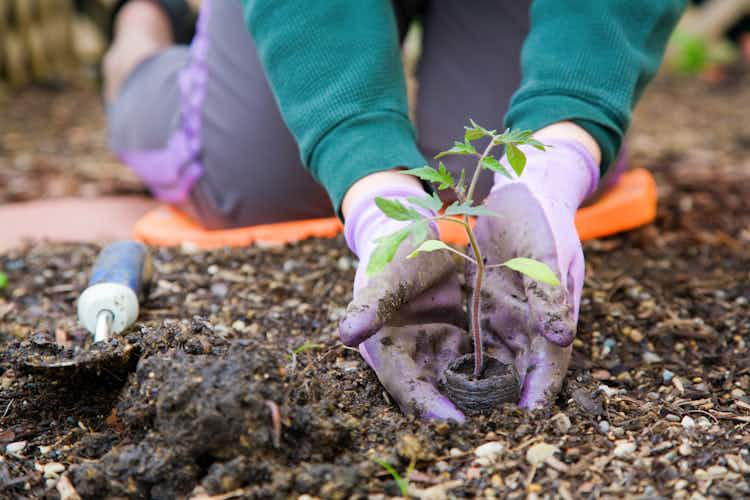Believe it or not, you can get free seeds to start growing fruits, veggies, and flowers. And you may be surprised to learn that you can get them at your local library, online, or even at a farmer’s market.
Depending on what you plan on growing, seeds can range from a dollar to hundreds of dollars, depending on the count (by weight or variety), specialty/hybrid, and organic/non-GMO breeding. We’ll show you some of our favorite ways to get free seeds, when they’re available, and how you can pick them up.
Make sure to also read about our tips on Lowe’s free garden kits, how to get free trees from the government, and our favorite places to find garden supplies online. For tons more high-value freebies, download The Krazy Coupon Lady app.
Get free seeds (and give free seeds) through a community seed library.
Seed libraries can be found in a variety of places, including:
Local libraries: Many public libraries have seed libraries where members can borrow seeds for their gardens. Find your local library and ask if they have a seed library.
Community centers: Community centers often have seed libraries as part of their programming.
Farmer’s markets: Some farmer’s markets have seed vendors or seed libraries. Find your local farmer’s market by entering your zip code.
Non-profit organizations: Non-profit organizations focused on gardening or sustainable agriculture may have seed libraries or be able to point you in the direction of one. For example, the American Community Gardening Association has a list of community gardens with contact information.
Online: There are many online seed libraries that offer a wide variety of seeds for purchase or exchange.
Friends and neighbors: You can also start your own seed library by exchanging seeds with friends and neighbors who have gardens.
It’s a good idea to check with local organizations or search online for seed libraries in your area to find one that best suits your needs.
Join the Free Plants By Mail plant club for a new plant each month.
Free Plants By Mail will send you a new plant in a 2-inch pot every month when you join their plant club. You do have to pay an $8.95 shipping fee every month. They ship every 30 days after your joining date.
The featured plant is posted on their website, so you won’t have to wonder what you’re getting. Plus, they include care instructions so you can prevent killing the plant.
And if you’re wondering, no, your plant won’t die in the mail, according to Free Plants By Mail. They pick species that are especially hardy and able to withstand a postal journey.
As long as you’re considering plants, learn how to save on hanging flower baskets.
Enter for a free wildflower seed giveaway from manufacturers.
In previous years, manufacturers let the public complete entry forms to receive free wildflower seeds. We’re anticipating similar programs in 2023, and we’ll update this section with new links once they’re available. As you can imagine, supplies go fast!
Here are some giveaways that I saw in 2022:
Free Wildflower Seeds From Air Wick and the World Wildlife Foundation: Fill out an online entry form and receive one pack of wildflower seeds for free. Limited to one per person, per address, and not for residents of Alaska or Hawaii.
Bayer’s Feed a Bee Program: Provide your name and address on the program’s website to receive free wildflower seeds to plant.
Arm & Hammer’s Wildflower Seeds Program: On Earth Day, sign up for free wildflower seeds.
Request free seeds from nonprofit organizations.
To get free milkweed seeds, the Live Monarch Foundation just asks for you to cover postage for the written request and include a self-addressed stamped envelope for the seeds to be returned. You can also order online. This “free” seed program is targeted at kids, educators, and those who cannot afford seeds. Otherwise, the cost starts at $5.90 for 150 seeds.
Find free seeds in your very own kitchen.
The best way to harvest seeds from your produce is to buy organic as much as possible. Then use pieces of your produce to start your garden. Here are some of our favorite things to do with scraps from the kitchen:
Plant dried beans and peas into dirt — they’ll grow!
Cut off 2 inches from the bottom of your whole celery stalks and stick them in a small pot of fresh water — they’ll grow new celery!
Do the same thing with a discarded head of lettuce to grow more.
Plant a piece of a potato that has developed “eyes” in three inches of dirt in a sunny spot — you’ll start to see new shoots in two weeks.
Fill a wide pot with soil a few inches from the top. Spread a couple of 1/4-inch thick tomato slices on top and cover with a light layer of soil. Water sporadically and make sure they get a good mix of sun and shade.
Anything else that has seeds is fair game for your garden (as long as your climate supports it). Sadly I’m not growing an orange tree in Idaho.
Related: Check out these genius gardening hacks you’ll regret not knowing.
The government gives out free seeds to plant breeders and researchers (not home gardeners).
You may have heard that the USDA provides free samples of seeds through mail. However, they’re really careful about only sending seeds to scientists, researchers, geneticists, and plant breeders. Some people will try to find a workaround to get these seeds, but I’ll tell you now that it’s not worth it.
The site you order from isn’t user-friendly, and the entire ordering process is pretty complicated.
Host a seed swap with friends and neighbors.
SeedSavers is a widely known marketplace for heirloom seeds, but they have a lesser-known online bulletin board where gardeners exchange seeds.
The exchange’s search is a little difficult to use, but the best way to use it is to search for something general in the search bar (like “flower”) and then filter the search results by your state.
If you’re feeling especially extroverted, you could host a neighborhood seed swap of your own. And if you’re introverted, you’ll just have to calculate whether the social interaction is worth the free seeds.
Cut, divide, and repopulate your own plants.
Receive free trees from the Arbor Day Foundation.
Not sure you need 10 trees? Consider going in with a few friends. If you donate $10 you’ll get 10 beautiful new trees to plant in your yard, plus two flowering bushes to split. Not to mention you’re helping the Arbor Day Foundation on their mission to plant, nurture, and celebrate trees around the globe. Now that’s what we call money well spent!
Now that you’ve identified your free seed sources, here’s everything you need to know about seeds and planting:
Garden Seeds 101
We know you’re excited to start growing your own food and watching your favorite flowers bloom, but the exact start date depends on your location.
What the Heck is a Zone?
As a budding gardener, there are two zones to know — plant hardiness and heat. Each zone map is divided into 12 regions. Stick to plants within your zone for the best results.
Thanks to the USDA’s Plant Hardiness Zone Map, you can pinpoint how well your plants will survive based on the average annual minimum temperature according to your zip code. It’s a range of temperatures like -20 degrees to -10 degrees Fahrenheit. With this info, you can select plants that can survive and thrive. Of course, weather changes, so these maps aren’t absolute but rather a guide to follow.
The Plant-Heat Zone Map from the American Horticulture Society lists the average number of days (aka heat patterns) when the temperature is above 86 degrees. Heat zones are sometimes listed on plant labels, and they explain how well your plants can tolerate hot temperatures.
How Soon Can I Pick Up Seeds?
Shop for seeds between January and March. Pick your favorite things to eat to make it simple, and think about how much space you have to grow.
Seed Types
Have you ever wondered what the seed terminology means? Let us help:
GMO: Not naturally derived; biologically engineered
Organic: Seeds from certified organic plants
Open pollination: Identical seeds from the parent plant and pollinated by bees, wind, birds, and other natural sources.
Heirloom: Defined as seeds older than 50 years; open pollination variety
Hybrid: Cross pollination of two varieties
Annuals Vs. Perennials
If you’re like me and forget which starter plants to choose every year, listen up. Don’t let the name fool you — annuals don’t return and perennials do.
Annuals need to be replanted every season, while perennials regrow every spring on their own. Perennials usually grow for several years (i.e., three to four growing seasons), so filling out a garden journal and planner would be helpful.
When Can I Start Actually Planting?
Once you know what zone you’re in, choose your seeds or starter plants. Certain varieties perform well by starting them indoors before transferring them to pots or raised garden beds. Think about broccoli, cabbage, and tomatoes.
As for when to start planting, it will be after your region’s last frost date, which is below 32 degrees Fahrenheit. Shoot for March. I’ll admit, some areas are fickle, and just when you think it won’t snow again, it does. For example, the Chicagoland area has seen snow in May which makes it very tricky to plan your first planting season.
Where to Buy Inexpensive Garden Seeds
We know that free seeds are the goal here, but sometimes time runs out or the program runs low. Well, we have a few other low cost options to find seeds:
Dollar Tree
In the beginning of the year, you’ll start seeing Dollar Tree‘s garden section pop up. In addition to potting soil, gloves, and pots, the discount chain sells seeds (typically the American Seed Company brand). The variety may vary, but I’ve seen seeds for vegetables and flowers, all for $1.25 each. Shoppers also have seen seed packets, 4 for $1.
Etsy
The Etsy Seeds page has varieties starting from $1 to $40. I’ve seen seeds for cucumbers, flowers, sunflowers, and succulents. Some sellers even have 50% off sales.
Ace Hardware
Don’t count this retailer out when you’re planning your garden. As of writing this, they have assorted garden seeds for $0.99 each.
Lowe’s
In April 2021 and 2022, Lowe’s had a springtime promotion where they gave out free Garden-to-Go-Kits. We expect a repeat for 2023. The registration process is quite competitive, so act quickly. The kit contents vary, but it’s a free way to start gardening.
Amazon
In March 2022, Amazon had an incredible deal on vegetable seeds — $34 for one pound. While it was only 22% off, it can yield up to 2,300 pounds of produce.


Tell us what you think
We're having a little work done... Comments will be back soon!